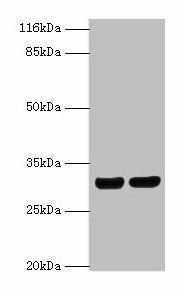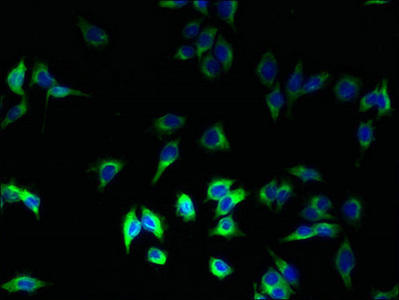Description
HLA-DRB1 Antibody (PACO33972)
The HLA-DRB1 Monoclonal Antibody (PAC033972) is a valuable tool for researchers studying the human leukocyte antigen (HLA) system and its role in immune response. This antibody, produced using cutting-edge technology, specifically targets the HLA-DRB1 protein, a major histocompatibility complex (MHC) class II molecule involved in antigen presentation to T cells.With its high specificity and sensitivity, this antibody is ideal for use in applications such as immunohistochemistry, flow cytometry, and ELISA. Its ability to detect HLA-DRB1 expression in various cell types and tissues makes it a versatile tool for investigating the role of HLA-DRB1 in autoimmune diseases, infectious diseases, and transplantation immunology.
By enabling researchers to study the expression and function of HLA-DRB1, this antibody can provide valuable insights into the mechanisms underlying immune responses and help in the development of targeted therapies for diseases associated with HLA dysregulation. Its reliability and performance make it a valuable asset for any laboratory conducting research in immunology, transplantation, and personalized medicine.
| Antibody Name: | HLA-DRB1 Antibody (PACO33972) |
| Antibody SKU: | PACO33972 |
| Size: | 50ug |
| Host Species: | Rabbit |
| Tested Applications: | ELISA, WB, IF |
| Recommended Dilutions: | ELISA:1:2000-1:10000, WB:1:1000-1:5000, IF:1:50-1:200 |
| Species Reactivity: | Human |
| Immunogen: | Recombinant Human HLA class II histocompatibility antigen, DRB1-12 β chain protein (30-266AA) |
| Form: | Liquid |
| Storage Buffer: | Preservative: 0.03% Proclin 300 Constituents: 50% Glycerol, 0.01M PBS, PH 7.4 |
| Purification Method: | >95%, Protein G purified |
| Clonality: | Polyclonal |
| Isotype: | IgG |
| Conjugate: | Non-conjugated |
 | Western blot All lanes: HLA-DRB1 antibody at 2µg/ml Lane 1: A375 whole cell lysate Lane 2: Raji whole cell lysate Secondary Goat polyclonal to rabbit IgG at 1/10000 dilution Predicted band size: 30 kDa Observed band size: 30 kDa . |
 | Immunofluorescent analysis of A375 cells using PACO33972 at dilution of 1:100 and Alexa Fluor 488-congugated AffiniPure Goat Anti-Rabbit IgG(H+L). |
| Background: | Binds peptides derived from antigens that access the endocytic route of antigen presenting cells (APC) and presents them on the cell surface for recognition by the CD4 T-cells. The peptide binding cleft accommodates peptides of 10-30 residues. The peptides presented by MHC class II molecules are generated mostly by degradation of proteins that access the endocytic route, where they are processed by lysosomal proteases and other hydrolases. Exogenous antigens that have been endocytosed by the APC are thus readily available for presentation via MHC II molecules, and for this reason this antigen presentation pathway is usually referred to as exogenous. As membrane proteins on their way to degradation in lysosomes as part of their normal turn-over are also contained in the endosomal/lysosomal compartments, exogenous antigens must compete with those derived from endogenous components. Autophagy is also a source of endogenous peptides, autophagosomes constitutively fuse with MHC class II loading compartments. In addition to APCs, other cells of the gastrointestinal tract, such as epithelial cells, express MHC class II molecules and CD74 and act as APCs, which is an unusual trait of the GI tract. To produce a MHC class II molecule that presents an antigen, three MHC class II molecules (heterodimers of an α and a β chain) associate with a CD74 trimer in the ER to form a heterononamer. Soon after the entry of this complex into the endosomal/lysosomal system where antigen processing occurs, CD74 undergoes a sequential degradation by various proteases, including CTSS and CTSL, leaving a small fragment termed CLIP (class-II-associated invariant chain peptide). The removal of CLIP is facilitated by HLA-DM via direct binding to the alpha-beta-CLIP complex so that CLIP is released. HLA-DM stabilizes MHC class II molecules until primary high affinity antigenic peptides are bound. The MHC II molecule bound to a peptide is then transported to the cell membrane surface. In B-cells, the interaction between HLA-DM and MHC class II molecules is regulated by HLA-DO. Primary dendritic cells (DCs) also to express HLA-DO. Lysosomal microenvironment has been implicated in the regulation of antigen loading into MHC II molecules, increased acid, fication produces increased proteolysis and efficient peptide loading. |
| Synonyms: | HLA class II histocompatibility antigen, DRB1-12 β chain (MHC class II antigen DRB1*12) (DR-12) (DR12), HLA-DRB1 |
| UniProt Protein Function: | Binds peptides derived from antigens that access the endocytic route of antigen presenting cells (APC) and presents them on the cell surface for recognition by the CD4 T-cells. The peptide binding cleft accommodates peptides of 10-30 residues. The peptides presented by MHC class II molecules are generated mostly by degradation of proteins that access the endocytic route, where they are processed by lysosomal proteases and other hydrolases. Exogenous antigens that have been endocytosed by the APC are thus readily available for presentation via MHC II molecules, and for this reason this antigen presentation pathway is usually referred to as exogenous. As membrane proteins on their way to degradation in lysosomes as part of their normal turn-over are also contained in the endosomal/lysosomal compartments, exogenous antigens must compete with those derived from endogenous components. Autophagy is also a source of endogenous peptides, autophagosomes constitutively fuse with MHC class II loading compartments. In addition to APCs, other cells of the gastrointestinal tract, such as epithelial cells, express MHC class II molecules and CD74 and act as APCs, which is an unusual trait of the GI tract. To produce a MHC class II molecule that presents an antigen, three MHC class II molecules (heterodimers of an alpha and a beta chain) associate with a CD74 trimer in the ER to form a heterononamer. Soon after the entry of this complex into the endosomal/lysosomal system where antigen processing occurs, CD74 undergoes a sequential degradation by various proteases, including CTSS and CTSL, leaving a small fragment termed CLIP (class-II-associated invariant chain peptide). The removal of CLIP is facilitated by HLA-DM via direct binding to the alpha-beta-CLIP complex so that CLIP is released. HLA-DM stabilizes MHC class II molecules until primary high affinity antigenic peptides are bound. The MHC II molecule bound to a peptide is then transported to the cell membrane surface. In B-cells, the interaction between HLA-DM and MHC class II molecules is regulated by HLA-DO. Primary dendritic cells (DCs) also to express HLA-DO. Lysosomal microenvironment has been implicated in the regulation of antigen loading into MHC II molecules, increased acidification produces increased proteolysis and efficient peptide loading. |
| UniProt Protein Details: | |
| NCBI Summary: | HLA-DRB1 belongs to the HLA class II beta chain paralogs. The class II molecule is a heterodimer consisting of an alpha (DRA) and a beta chain (DRB), both anchored in the membrane. It plays a central role in the immune system by presenting peptides derived from extracellular proteins. Class II molecules are expressed in antigen presenting cells (APC: B lymphocytes, dendritic cells, macrophages). The beta chain is approximately 26-28 kDa. It is encoded by 6 exons. Exon one encodes the leader peptide; exons 2 and 3 encode the two extracellular domains; exon 4 encodes the transmembrane domain; and exon 5 encodes the cytoplasmic tail. Within the DR molecule the beta chain contains all the polymorphisms specifying the peptide binding specificities. Hundreds of DRB1 alleles have been described and typing for these polymorphisms is routinely done for bone marrow and kidney transplantation. DRB1 is expressed at a level five times higher than its paralogs DRB3, DRB4 and DRB5. DRB1 is present in all individuals. Allelic variants of DRB1 are linked with either none or one of the genes DRB3, DRB4 and DRB5. There are 4 related pseudogenes: DRB2, DRB6, DRB7, DRB8 and DRB9. [provided by RefSeq, Jul 2008] |
| UniProt Code: | Q95IE3 |
| NCBI GenInfo Identifier: | 74760669 |
| NCBI Gene ID: | 3123 |
| NCBI Accession: | Q95IE3.1 |
| UniProt Secondary Accession: | Q95IE3,O19585, Q19AF2, Q29771, Q2L9H4, Q2MZ92, Q5EER6 Q5NDB9, A7LA26, B0LUZ6 |
| UniProt Related Accession: | Q95IE3,P01911, P01912, P04229, P20039, Q29974, Q30134, Q30167, Q5Y7A7, Q95IE3 |
| Molecular Weight: | 29,878 Da |
| NCBI Full Name: | HLA class II histocompatibility antigen, DRB1-12 beta chain |
| NCBI Synonym Full Names: | major histocompatibility complex, class II, DR beta 1 |
| NCBI Official Symbol: | HLA-DRB1 |
| NCBI Official Synonym Symbols: | SS1; DRB1; HLA-DRB; HLA-DR1B |
| NCBI Protein Information: | major histocompatibility complex, class II, DR beta 1 |
| UniProt Protein Name: | HLA class II histocompatibility antigen, DRB1-12 beta chain |
| UniProt Synonym Protein Names: | MHC class II antigen DRB1*12; DR-12; DR12 |
| Protein Family: | HLA class II histocompatibility antigen |
| UniProt Gene Name: | HLA-DRB1 |
| UniProt Entry Name: |






